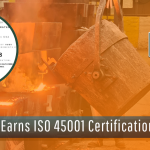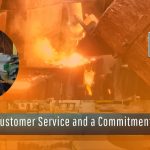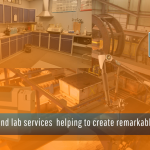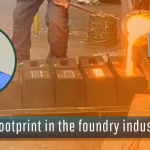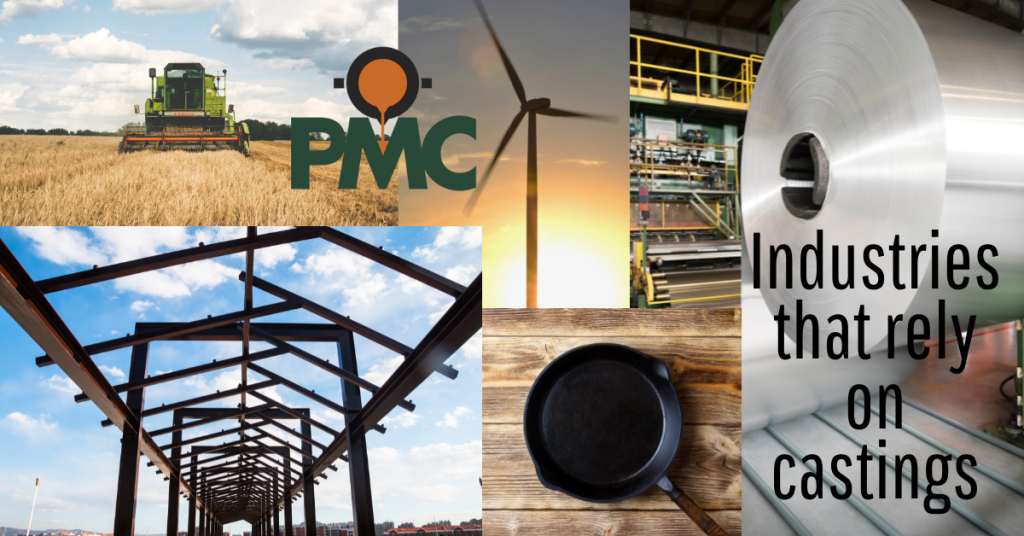
Metal casters can develop complex shapes in many sizes using a wide variety of materials with unique properties that serve many different purposes. That’s why metal castings are vital to many key industries such as agriculture, healthcare, and mining. Without castings, these industries and the role they play in our everyday lives wouldn’t be the same.
Agriculture
“Agriculture is the world’s oldest industry; without it, society as we know it would not exist (avalon-castings.com, n.d.). Farmers grow the food that feeds the world. That’s why technology and equipment are very important to this industry. “Three challenges are common to agricultural machinery: harsh conditions, large loads, and an evolving technology that requires well-designed parts and precision production” (soucybelgen.com, 2014). In this industry, durability and productivity are key qualities of modern farm equipment. That’s why cast iron and steel are extremely important in the development of parts used in farming equipment.
Some examples of hard-working cast parts in this industry are:
- Frames for agricultural vehicles,
- Drums,
- Cylinders
- Gear casings or housings.
These parts are critical elements in the structure and movement of agricultural vehicles. Without castings, creating the complex shapes necessary to make these key parts and assemblies would be nearly impossible.
That, in turn, would cause the output of the agriculture industry to be much lower than it is today. According to the U.S. Department of Agriculture, total agricultural output nearly tripled between 1948 and 2015 (Wang, Nehring, Mosheim, 2018). It’s fair to say that metal castings played a big part in that massive productivity leap.
Automotive
Since the making of the first vehicle, castings and cars have had a strong relationship. In the late 1800s, when automobiles were invented, cars were much simpler. Today, some have more than 3,000 parts. Of those, some of the most important components and assemblies are metal castings.
One example is the engine block. It’s usually made from cast iron or aluminum alloy. It “contains all of the major components that make up the bottom end of a motor. This is where the crankshaft spins, and the pistons move up and down in the cylinder bores, fired by the fuel combusting…Its metal construction gives it strength and the ability to transmit heat from the combustion processes to the integral cooling system in an efficient manner” (haynes.com, n.d.).
Additionally, die castings composed of aluminum, magnesium, and zinc are being employed by vehicle manufacturers to produce cleaner and safer vehicles that use less fuel and produce lower emission levels (diecasting.org, n.d.).
Not only does the casting industry help the auto industry get us where we need to go every day, but our industry is also helping make the world a better, safer, and more sustainable place – one casting at a time.
Culinary
From cast iron sinks and stoves to cast iron skillets, metal castings are all over your kitchen.
Using a cast-iron skillet allows an even distribution of heat, and if seasoned, provides great taste and prevents food from sticking. It also lasts a long time and is versatile and cost-effective.
“Cast iron’s distinctive properties enable manufacturers to produce an entire stove from one mold. While this three-dimensional casting process allows for attractive stove angles and patterns, the technique also eliminates seam weld fatigue problems that plaque stoves made from welded components. Cast iron wood stoves also adapt well to high temperatures and extremely fast temperature changes” (Hazelden, n.d.).
Mining
The mining and casting industries are connected in multiple ways. The casting industry relies on mining to provide the metals we use in our processes. These metals are then used to develop the durable castings that the mining industry relies on to dig overburden and ore out of the ground, 24 hours a day, 7 days a week – while enduring some of the harshest conditions on Earth.
Some of the cast metal parts used within the mining industry include:
- eccentrics for shakers and crushers
- clamping rings
- pinion shaft housings
- wheel hubs for large mining trucks
This symbiotic relationship between the casting and mining industries allows metal castings to be a solution in all the other industries we are discussing in this article.
Construction
For centuries, cast iron and steel have been heavily relied upon as sturdy, foundational, and architectural materials in the construction industry. These are the castings you see and use every day, and without them, many components of our everyday lives would be much less durable and useful.
According to theconstructor.org, the construction industry uses castings for:
- manhole covers
- sewer pipes
- lamp posts
- bridges
- building frames
- gates
The strength and longevity of metal castings make them a key part of machines, parts, building materials, and other items construction workers need on the job site to do quality work. Without castings, it would be much more difficult to build long-lasting buildings, bridges, and structures that can bear heavy loads and pressures. Castings are highly important for safety within the construction industry.
Health Care
Not only do castings help promote safety, but they also help promote health. The healthcare and medical industries rely on many cast components within their medical tools and devices to provide the best care possible to patients every day.
The metal casting industry is responsible for the development of “parts for products such as pacemakers, patient monitoring systems and ultrasound systems” (diecasting.com, n.d.). Such parts are commonly made through the aluminum die casting process.
Making parts for the medical industry requires a great deal of precision in both engineering and design. Metal casting is the only technique of manipulating metal that enables this kind of flexibility of shape and design. Without it, it’s possible that some of the important medical solutions and devices medical professionals rely on would not be available today.
Paper
Within the paper industry, castings are very important to the machines used in paper mills. We use paper every day in the form of textbooks, notebooks, sketchbooks, tissue paper, wrapping paper, checks, bills, and receipts, just to name a few.
Despite a recent push to reduce our use of paper to help protect the environment, paper, and the castings that drive its production continues to be extremely important to our everyday lives.
Some important cast components for this industry include:
- gears
- housings
- dryer heads
- pulleys
Technology is amazing in the way it gives us a way to access books and bills and mail in a way that reduces our consumption of paper. However, there’s still nothing like turning the pages of a real book or putting pencil to paper. Though we are quite advanced, paper is still something we need in many ways today.
Alternative Energy
Another important industry impacted by castings is renewable energy. In order to harness energy, many cast components are required to build things like solar panels and windmills.
The most important part of a windmill is the hub. The hub is the center point of the windmill where all the blades are joined. It also houses the complex technology that turns the blades and harnesses its energy. The hub must also be able to bear all the weight and movement of the blades. In order to ensure the strength, durability, and longevity of windmills, hubs are made from cast steel, steel alloys, or aluminum (qualitasexports.com, n.d.).
Metal casting enables the creation of large, complex shapes that can withstand incredible amounts of motion, weather, and weight. Without the casting industry, alternative energy would not be the plentiful, accessible, reliable resource it is today.
Works Cited
“3 Common Industrial Uses Of Structural Steel.” Edmonton Structural Steel Fabrication, 29 Nov. 2016, http://northern-weldarc.com/3-common-industrial-uses-structural-steel/.
Advanced Solutions International, Inc. Shaping America’s Future, https://www.diecasting.org/wcm/Die_Casting/Shaping_America_s_Future/wcm/Die_Casting/DC_Shape.aspx?hkey=ef77621e-91b7-47cb-ba35-f4d8e1671a1a.
“Agricultural Productivity Growth in the United States: 1948-2015.” USDA ERS – Agricultural Productivity Growth in the United States: 1948-2015, https://www.ers.usda.gov/amber-waves/2018/march/agricultural-productivity-growth-in-the-united-states-1948-2015/.
“Applications of Ductile Iron Castings.” Ductile Iron Castings Find Applications in Diverse Industries like Piping, Automobile, Etc., https://qualitasexports.com/articles/ductile-iron-castings-applications.
“Beginner’s Guide: What Is an Engine Block (and What Does It Do)?” Haynes Manuals, 20 Mar. 2019, https://haynes.com/en-us/tips-tutorials/what-is-engine-block-what-does-it-do.
“Cast Iron as a Building Material- Types, Properties and Uses.” The Constructor, 18 Sept. 2017, https://theconstructor.org/building/cast-iron-types-properties-uses/16022/.
“Engine Block Manufacturing Process.” Engine Block Manufacturing Process, https://newengineeringpractice.blogspot.com/2011/08/engine-block-manufacturing-process.html.
“Foundries Accelerate Auto Efforts.” Semiconductor Engineering, 19 July 2017, https://semiengineering.com/foundries-accelerate-auto-efforts/.
“Industries.” Cast Iron Parts for Industrial Equipment Manufacturer | Soucy Belgen, http://www.soucybelgen.com/en-CA/industries.
“Medical Devices.” Die Casting for Medical Device Parts | Premier Die Casting, https://diecasting.com/industries/medical-devices.php.
User, Super. “Agriculture Castings.” Agriculture Equipment Castings | Avalon Precision Metalsmiths, https://www.avalon-castings.com/industries/agriculture-castings.html.
“Uses of Cast Iron.” Hunker, https://www.hunker.com/13412291/uses-of-cast-iron. “Windmill Hubs.” Working and Components of a Windmill, Windmill Hub Casting Manufacturers., https://qualitasexports.com/articles/windmill-hubs.

